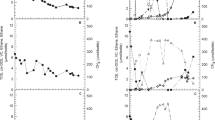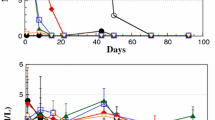Abstract
Experiments with trichloroethylene-contaminated aquifer material demonstrated that TCE, cis-DCE, and VC were completely degraded with concurrent Fe(III) or Fe(III) and sulfate reduction when acetate was amended at stoichiometric concentration; competing TEAPs did not inhibit ethene production. Adding 10× more acetate did not increase the rate or extent of TCE reduction, but only increased methane production. Enrichment cultures demonstrated that ~90 μM TCE or ~22 μM VC was degraded primarily to ethene within 20 days with concurrent Fe(III) or Fe(III) + sulfate reduction. The dechlorination rates were comparable between the low and high acetate concentrations (0.36 vs 0.34 day−1, respectively), with a slightly slower rate in the 10× acetate amended incubations. Methane accumulated to 13.5 (±0.5) μmol/tube in the TCE-degrading incubations with 10× acetate, and only 1.4 (±0.1) μmol/tube with low acetate concentration. Methane accumulated to 16 (±1.5) μmol/tube in VC-degrading enrichment with 10× acetate and 2 (±0.1) μmol/tube with stoichiometric acetate. The estimated fraction of electrons distributed to methanogenesis increased substantially when excessive acetate was added. Quantitative PCR analysis indicated that 10× acetate did not enhance Dehalococcoides biomass but rather increased the methanogen abundance by nearly one order of magnitude compared to that with stoichiometric acetate. The data suggest that adding low levels of substrate may be equally if not more effective as high concentrations, without producing excessive methane. This has implications for field remediation efforts, in that adding excess electron donor may not benefit the reactions of interest, which in turn will increase treatment costs without direct benefit to the stakeholders.






Similar content being viewed by others
References
Ballapragada BS, Stensel HD, Puhakka JA, Ferguson JF (1997) Effect of hydrogen on reductive dechlorination of chlorinated ethenes. Environ Sci Technol 31:1728–1734
Bennett P, Gandhi D, Warner S, Bussey J (2007) In situ reductive dechlorination of chlorinated ethenes in high nitrate groundwater. J Hazard Mater 149:568–573
Bratt WB, Bagwell CE, Nevius B, Brigmon RL, Freedman DL (2004) Characterization of reductive dechlorination activity in a TCE-contaminated aquifer at the savannah river site (SRS). In: Paper presented at ASM, ASM, New Orleans
Cabirol N, Perrier J, Jacob F, Fouillet B, Chambon P (1996) Role of methanogenic and sulfate-reducing bacteria in the reductive dechlorination of tetrachloroethylene in mixed culture. Bull Environ Contam Toxicol 56:817–824
Cabirol N, Jacob F, Perrier J, Fouillet B, Chambon P (1998a) Complete degradation of high concentrations of tetrachloroethylene by a methanogenic consortium in a fixed-bed reactor. J Biotechnol 62:133–141
Cabirol N, Jacob F, Perrier J, Fouillet B, Chambon P (1998b) Interaction between methanogenic and sulfate-reducing microorganisms during dechlorination of a high concentration of tetrachloroethylene. J Gen Appl Microbiol 44:297–301
Chapelle FH, Bradley PM (2000) Redox conditions and the efficiency of chlorinated ethene biodegradation: field studies. In: Abstracts of papers presented at 220th ACS National Meeting, ACS, Washington DC, 20–24 August 2000
Cord-Ruwisch R, Lovley DR, Schink B (1998) Growth of Geobacter sulfurreducens with acetate in syntrophic cooperation with hydrogen-oxidizing anaerobic partners. Appl Environ Microbiol 64:2232–2236
Delong EF (1992) Archaea in coastal marine environments. Proc Natl Acad Sci USA 89:5685–5689
Distefano TD, Gossett JM, Zinder SH (1991) Reductive dechlorination of high concentrations of tetrachloroethene to ethene by an anaerobic enrichment culture in the absence of methanogenesis. Appl Environ Microbiol 57:2287–2292
Doong R, Wu S, Chen T (1996) Anaerobic biotransformation of polychlorinated methane and ethene under various redox conditions. Chemosphere 32:377–390
Duhamel M, Mo K, Edwards EA (2004) Characterization of a highly enriched Dehalococcoides-containing culture that grows on vinyl chloride and trichloroethene. Appl Environ Microbiol 70:5538–5545
Elshahed MS, Najar FZ, Roe BA, Oren A, Dewers TA, Krumholz LR (2004) Survey of archaeal diversity reveals an abundance of halophilic Archaea in a low-salt, sulfide- and sulfur-rich spring. Appl Environ Microbiol 70:2230–2239
Evans PJ, Koenigsberg SS (2001) A bioavailable ferric iron assay and relevance to reductive dechlorination. In: Sixth international in situ and on-site bioremediation symposium, San Diego
Fennell DE, Gossett JM (1998) Modeling the production of and competition for hydrogen in a dechlorinating culture. Environ Sci Technol 32:2450–2460
Fennell DE, Gossett JM, Zinder SH (1997) Comparison of butyric acid, ethanol, lactic acid, and propionic acid as hydrogen donors for the reductive dechlorination of tetrachloroethene. Environ Sci Technol 31:918–926
Fennell DE, Carroll AB, Gossett JM, Zinder SH (2001) Assessment of indigenous reductive dechlorinating potential at a TCE-contaminated site using microcosms, polymerase chain reaction analysis, and site data. Environ Sci Technol 35:1830–1839
Finneran KT, Lovley DR (2001) Anaerobic degradation of methyl tert-butyl ether (MTBE) and tert-butyl alcohol (TBA). Environ Sci Technol 35:1785–1790
Freedman DL, Yu R, Hickey MR (2011) Evaluation of reductive dechlorination of chlorinated ethenes at low pH levels. Paper presented at Battelle International Symposium on Bioremediation and Sustainable Environmental Technologies, Reno
Gibson SA, Roberson DS, Russell HH, Sewell GW (1994) Effects of three concentrations of mixed fatty acids on dechlorination of tetrachloroethene in aquifer microcosms. Environ Toxicol Chem 13:453
Gossett JM (2010) Sustained aerobic oxidation of vinyl chloride at low oxygen concentrations. Environ Sci Technol 44:1405–1411
He J, Sung Y, Dollhopf ME, Fathepure BZ, Tiedje JM, Loffler FE (2002) Acetate versus hydrogen as direct electron donors to stimulate the microbial reductive dechlorination process at chloroethene-contaminated sites. Environ Sci Technol 36:3945–3952
Heimann AC, Friis AK, Scheutz C, Jakobsen R (2007) Dynamics of reductive TCE dechlorination in two distinct H-2 supply scenarios and at various temperatures. Biodegradation 18:167–179
Illman WA, Alvarez PJ (2009) Performance assessment of bioremediation and natural attenuation. Crit Rev Environ Sci Technol 39:209–270
Kennes C, Veiga MC, Bhatnagar L (1998) Methanogenic and perchloroethylene-dechlorinating activity of anaerobic granular sludge. Appl Microbiol Biotechnol 50:484–488
Klocke M, Nettmann E, Bergmann I, Mundt K, Souidi K, Mumme J, Linke B (2008) Characterization of the methanogenic archaea within two-phase biogas reactor systems operated with plant biomass. Syst Appl Microbiol 31:190–205
Kouznetsova I, Mao XM, Robinson C, Barry DA, Gerhard JI, McCarty PL (1998) Biological reduction of chlorinated solvents: batch-scale geochemical modeling. Adv Water Resour 33:969–986
Kromann A, Ludvigsen L, Albrechtsen H-J, Christensen TH, Ejlertsson J, Svensson BH (1998) Degradability of chlorinated aliphatic compounds in methanogenic leachates sampled at eight landfills. Waste Manage Res 16:54
Krumholz LR (1997) Desulfuromonas chloroethenica sp. nov. uses tetrachloroethylene and trichloroethylene as electron acceptors. Int J Syst Bacteriol 47:1262–1263
Krumholz LR, Sharp R, Fishbain SS (1996) A freshwater anaerobe coupling acetate oxidation to tetrachloroethylene dehalogenation. Appl Environ Microbiol 62:4108–4113
Leahy JG, Shreve GS (2000) The effect of organic carbon on the sequential reductive dehalogenation of tetrachloroethylene in landfill leachates. Water Res 34:2390–2396
Lee MD, Odom JM, Buchanan RJ (1998) New perspectives on microbial dehalogenation of chlorinated solvents: insights from the field. Annu Rev Microbiol 52:423–452
Lee IS, Bae JH, Yang YR, McCarty PL (2004) Simulated and experimental evaluation of factors affecting the rate and extent of reductive dehalogenation of chloroethenes with glucose. J Contam Hydrol 74:313–331
Lee IS, Bae JH, McCarty PL (2007) Comparison between acetate and hydrogen as electron donors and implications for the reductive dehalogenation of PCE and TCE. J Contam Hydrol 94(1–2):76–85
Lovley DR (1991) Dissimilatory Fe(III) and Mn(IV) reduction. Microbial Rev 55:59–287
Lovley DR, Phillips EJP (1986) Organic matter mineralization with reduction of ferric iron in anaerobic sediments. Appl Environ Microbiol 51:683–689
Lovley DR, Phillips EJP (1987) Rapid assay for microbially reducible ferric iron in aquatic sediments. Appl Environ Microbiol 53:1536–1540
Lovley DR, Giovannoni SJ, White DC, Champine JE, Phillips EJP, Gorby YA, Goodwin S (1993) Geobacter metallireducens gen. nov. sp. nov., a microorganism capable of coupling the complete oxidation of organic-compounds to the reduction of iron and other metals. Arch Microbiol 159:336–344
Major DW, McMaster ML, Cox EE, Edwards EA, Dworatzek SM, Hendrickson ER, Starr MG, Payne JA, Buonamici LW (2002) Field demonstration of successful bioaugmentation to achieve dechlorination of tetrachloroethene to ethene. Environ Sci Technol 36:5106–5116
McLean JE, Dupont RR, Sorensen DL (2006) Iron and arsenic release from aquifer solids in response to biostimulation. J Environ Qual 35:1193–1203
Morris RM, Fung JM, Rahm BG, Zhang S, Freedman DL, Zinder SH, Richardson RE (2007) Comparative proteomics of Dehalococcoides spp. reveals strain-specific peptides associated with activity. Appl Environ Microbiol 73:320–326
Mulligan CN, Yong RN (2004) Natural attenuation of contaminated soils. Environ Int 30:587–601
Perelo LW (2010) Review: in situ and bioremediation of organic pollutants in aquatic sediments. J Hazard Mater 177:81–89
Ritalahti KM, Amos BK, Sung Y, Wu QZ, Koenigsberg SS, Loffler FE (2006) Quantitative PCR targeting 16S rRNA and reductive dehalogenase genes simultaneously monitors multiple Dehalococcoides strains. Appl Environ Microbiol 72:2765–2774
Rivett MO, Thornton SF (2008) Monitored natural attenuation of organic contaminants in groundwater: principles and application. Proc Inst Civil Eng 161:381–392
Rodriguez E, McGuinness KA, Ophori DU (2004) A field evaluation of enhanced reductive dechlorination of chlorinated solvents in groundwater, New York Metropolitan Area. Environ Geol 45:623–632
Roling WFM, van Verseveld HW (2002) Natural attenuation: what does the subsurface have in store? Biodegradation 13:53–64
Scheutz C, Broholm MM, Durant ND, Weeth EB, Jorgensen TH, Dennis P, Jacobsen CS, Cox EE, Chambon JC, Bjerg PL (2010) Field evaluation of biological enhanced reductive dechlorination of chloroethenes in clayey till. Environ Sci Technol 44:5134–5141
Skubal KL, Barcelona MJ, Adriaens P (2001) An assessment of natural biotransformation of petroleum hydrocarbons and chlorinated solvents at an aquifer plume transect. J Contam Hydrol 49:151–169
Sung Y, Fletcher KF, Ritalaliti KM, Apkarian RP, Ramos-Hernandez N, Sanford RA, Mesbah NM, Loffler FE (2006) Geobacter lovleyi sp. nov. strain SZ, a novel metal-reducing and tetrachloroethene-dechlorinating bacterium. Appl Environ Microbiol 72:2775–2782
Takai K, Horikoshi K (2000) Rapid detection and quantification of members of the archaeal community by quantitative PCR using fluorogenic probes. Appl Environ Microbiol 66:5066–5072
Wei N, Finneran KT (2009) Microbial community analyses of three distinct, liquid cultures that degrade methyl tert-butyl ether using anaerobic metabolism. Biodegradation 20:695–707
Wei N, Finneran KT (2011) Influence of ferric iron on complete dechlorination of trichloroethylene (TCE) to ethene: Fe(III) reduction does not always inhibit complete dechlorination. Environ Sci Technol 45:7422–7430
Yang YR, McCarty PL (2002) Comparison between donor substrates for biologically enhanced tetrachloroethene DNAPL dissolution. Environ Sci Technol 36:3400–3404
Yang YR, McCarty PL (2003) Response to comment on “Comparison between donor substrates for biologically enhanced tetrachloroethene DNAPL dissolution”. Environ Sci Technol 37:2620–2621
Zaa CLY, McLean JE, Dupont RR, Norton JM, Sorensen DL (2010) Dechlorinating and iron reducing bacteria distribution in a TCE-contaminated aquifer. Ground Water Monit Remediat 30:46–57
Acknowledgments
We thank Dr. Michael Miller of Camp, Dresser, and McKee (CDM) for providing contaminated sediment/water samples, and thank Dr. Frank Loeffler for providing DHC sp. strain FL2 culture. This work was supported by the National Science Foundation Grant # 1102889.
Author information
Authors and Affiliations
Corresponding author
Electronic supplementary material
Below is the link to the electronic supplementary material.
Rights and permissions
About this article
Cite this article
Wei, N., Finneran, K.T. Low and high acetate amendments are equally as effective at promoting complete dechlorination of trichloroethylene (TCE). Biodegradation 24, 413–425 (2013). https://doi.org/10.1007/s10532-012-9598-x
Received:
Accepted:
Published:
Issue Date:
DOI: https://doi.org/10.1007/s10532-012-9598-x




